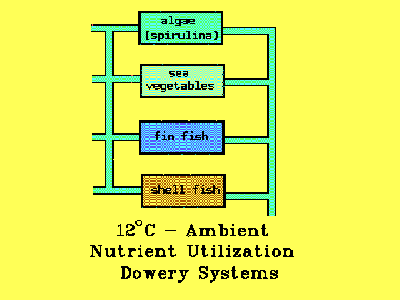THE NUTRIENT UTILIZATION SUBSYSTEM

After the deep ocean water has been employed in one or more cold
utilization applications it can be utilized again for the residual cold (about
13 degrees C) and the nutrients. The purity of the water is also employed for
the production of algae such as spirulina. Here the absence of competitor
organisms results in a very pure product. In addition the high solar insolation
has increased the production of beta carotin as a by-product of this alga and
the use of cold water to recover the combustion product from the butane that is
used to dry the algae, virtually eliminated the generation carbon dioxide during
the production process. Other experiments have shown that the deep ocean water
can be used for the production of kelp which is then fed to abalone and sea
urchins for a carefully controlled environmentally sustained process. Other sea
vegetables are also easily produced with increases in biomass of greater than
55% per day and as high as 80% per day. When cold water species of fin fish such
as salmon and steel head (saltwater) trout are added, then highly efficient
disease free high productivity aquaculture results. Other species which are now
commercially successful include the well known delicacy hirame and the very
popular Maine lobster..
One need not recapitulate to recognize that all of the elements of
environmental sustainability, self sufficiency, economic viability and
preservation of cultural identity are available from the use of deep ocean cold
water whenever and wherever it exists particularly in coastal communities of the
tropics.
HERE ENDETH, FOR THE TIME BEING, THE ESSAY ON ENVIRONMENTALLY SUSTAINABLE
DEVELOPMENT. IT IS TIME TO REIMMERSE IN SOME NEW OR RELATED TOPIC FROM THE INDEX PAGE
